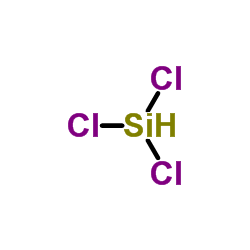Trichlorosilane

Trichlorosilane structure
|
Common Name | Trichlorosilane | ||
|---|---|---|---|---|
| CAS Number | 10025-78-2 | Molecular Weight | 135.452 | |
| Density | 1.342 g/mL at 25 °C(lit.) | Boiling Point | 31.8±9.0 °C at 760 mmHg | |
| Molecular Formula | Cl3HSi | Melting Point | -127 °C | |
| MSDS | Chinese USA | Flash Point | 7 °F | |
| Symbol |



GHS02, GHS05, GHS07 |
Signal Word | Danger | |
|
Fabrication of Self-Cleaning, Reusable Titania Templates for Nanometer and Micrometer Scale Protein Patterning.
ACS Nano 9 , 6262-70, (2015) The photocatalytic self-cleaning characteristics of titania facilitate the fabrication of reuseable templates for protein nanopatterning. Titania nanostructures were fabricated over square centimeter areas by interferometric lithography (IL) and nanoimprint l... |
|
|
On chip analysis of CNS lymphoma in cerebrospinal fluid.
Theranostics 5 , 796-804, (2015) Molecular profiling of central nervous system lymphomas in cerebrospinal fluid (CSF) samples can be challenging due to the paucicellular and limited nature of the samples. Presented herein is a microfluidic platform for complete CSF lymphoid cell analysis, in... |
|
|
Microprocessor-based integration of microfluidic control for the implementation of automated sensor monitoring and multithreaded optimization algorithms.
Biomed. Microdevices 17 , 82, (2015) Microfluidic applications range from combinatorial synthesis to high throughput screening, with platforms integrating analog perfusion components, digitally controlled micro-valves and a range of sensors that demand a variety of communication protocols. Curre... |
|
|
Modeling type 2 diabetes-like hyperglycemia in C. elegans on a microdevice.
Integr. Biol. (Camb.) 8 , 30-8, (2016) Caenorhabditis elegans (C. elegans) has been widely used as a model organism for biomedical research due to its sufficient homology with mammals at the molecular and genomic levels. In this work, we describe a microfluidic assay to model type 2 diabetes-like ... |
|
|
Quantifying morphological heterogeneity: a study of more than 1 000 000 individual stored red blood cells.
Vox Sang. 109 , 221-30, (2015) The morphology of red blood cells (RBCs) deteriorates progressively during hypothermic storage. The degree of deterioration varies between individual cells, resulting in a highly heterogeneous population of cells contained within each RBC unit. Current techni... |
|
|
Rapid and specific drug quality testing assay for artemisinin and its derivatives using a luminescent reaction and novel microfluidic technology.
Am. J. Trop. Med. Hyg. 92 , 24-30, (2015) Globally, it is estimated that about 10-30% of pharmaceuticals are of poor quality. Poor-quality drugs lead to long-term drug resistance, create morbidity, and strain the financial structure of the health system. The current technologies for substandard drug ... |
|
|
Characterization of surface confined ionic liquid stationary phases: impact of cation revisited.
J. Chromatogr. A. 1364 , 171-82, (2014) Modification of the Linear Solvation Energy Relationship (LSER) equation to account for ionic interactions in the retention of ionizable compounds has enabled the elucidation in the effect of the imidazolium cation identity on retention. Three Surface Confine... |
|
|
Agarose-assisted micro-contact printing for high-quality biomolecular micro-patterns.
Macromol. Biosci. 15 , 613-21, (2015) Micro-contact printing has been developed to print biomolecules, such as cell adhesive molecules, proteins, or DNAs, on a substrate, which can serve as experimental platforms for investigating biological issues and engineering biosensors. Despite the populari... |
|
|
Lewis base-catalyzed conjugate reduction and reductive aldol reaction of alpha,beta-unsaturated ketones using trichlorosilane.
Chem. Commun. (Camb.) (36) , 4309-11, (2008) Lewis bases such as Ph3P=O and HMPA catalyze the 1,4-reduction of alpha,beta-unsaturated ketones with trichlorosilane, and because the 1,2-reduction of aldehydes scarcely proceeded under the conditions, one-pot reductive aldol reactions with aldehydes were su... |
|
|
Direct detection and drug-resistance profiling of bacteremias using inertial microfluidics.
Lab Chip 15 , 2297-307, (2015) Detection of bacteria in bloodstream infections and their antibiotic susceptibility patterns is critical to guide therapeutic decision-making for optimal patient care. Current culture-based assays are too slow (>48 h), leading to excessive up-front use of bro... |